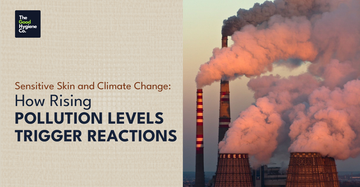If your sensitive skin seems to flush, sting, or feel uncomfortably tight more often than before, you’re not imagining things. Dermatologists worldwide are seeing a rise in climate change skin problems, and much of it is linked to environmental stressors—especially pollution.
From fine dust particles in the air to stronger UV rays and unpredictable weather swings, today’s climate is creating the perfect storm for irritation and barrier breakdown.
Why Sensitive Skin Is More Vulnerable
Sensitive skin isn’t an official medical diagnosis, but it refers to skin that overreacts to everyday triggers. Redness, itching, burning, and dryness are all common signs. What makes this skin type more reactive is a weakened skin barrier—the layer of lipids and cells that protect against irritants and lock in moisture.
When climate change alters our environment, sensitive skin often becomes the first to signal distress:
- Temperature fluctuations disrupt hydration levels.
- UV radiation intensifies oxidative stress.(1)
- Pollutants break down collagen and lipids.
In short, environmental stress directly amplifies irritation, leading to faster aging, increased dryness, and heightened reactivity.
How Climate Change Triggers Skin Problems
Climate change brings more than rising temperatures; it shifts the way our skin interacts with the environment. Some key impacts include:
1. Increased Air Pollution
- Fine particulate matter (PM2.5) clings to skin and penetrates follicles, leading to air pollution skin irritation.(2)
- Pollutants generate free radicals that damage proteins, lipids, and DNA in skin cells.
- Ozone interacts with natural oils in the skin, creating irritants that trigger stinging and redness.
2. Stronger UV Radiation
- With climate shifts, ozone layer depletion worsens UV exposure.
- UV and pollution combined accelerate inflammation, pigmentation, and barrier breakdown.
3. Unpredictable Weather Patterns
- Sudden heat waves increase transepidermal water loss, leaving sensitive skin parched.
- Cold, dry winds can strip the barrier, triggering eczema or dermatitis.
4. Microbiome Disturbances
- Pollution and changing climates may disrupt the skin’s natural microbiome.
- An imbalanced microbiome can worsen sensitivity, dryness, and flare-ups.
Common Climate Change Skin Problems
Here are some reactions increasingly linked to environmental changes:
- Persistent Redness and Flushing – Triggered by rising temperatures and pollutants that inflame blood vessels.
- Chronic Dryness – Humidity drops and heat waves speed up water loss, leaving skin tight and flaky.
- Hyperpigmentation – UV radiation and pollution together stimulate melanin, causing uneven tone.
- Eczema and Dermatitis – Fine particles and irritant gases aggravate inflammatory pathways, worsening flare-ups.
- Acne-like Breakouts – Pollutants oxidize oils, clog pores, and worsen breakouts.
What Research Tells Us
- Oxidative Stress as the Root Cause: Pollution and UV create reactive oxygen species (ROS), overwhelming the skin’s natural defenses. This results in inflammation, barrier lipid damage, and premature aging.
- Particulate Matter and Inflammation: Tiny pollutants activate receptors in skin cells that trigger inflammatory pathways. For sensitive skin, this means more frequent flare-ups.
- Ozone Damage: Studies show ozone exposure directly reduces antioxidants in skin, leaving it prone to irritation.
- Weather Extremes and Barrier Loss: Both hot, dry air and cold winds accelerate transepidermal water loss (TEWL), making skin feel rough and sore.(3)
- Indoor Air Factors: Volatile organic compounds (VOCs) and poor indoor ventilation can prolong low-grade irritation, showing that skin stress isn’t limited to outdoor exposure.
How to Protect Sensitive Skin in a Changing Climate
1. Gentle Cleansing
Opt for sulfate-free cleansers that remove dirt and pollutants without stripping natural oils. Over-cleansing can worsen irritation.
2. Barrier Repair Moisturizers
Look for creams with ceramides, fatty acids, cholesterol, and hyaluronic acid. These reinforce the skin’s barrier and keep moisture locked in.
3. Antioxidant Protection
Serums with vitamin C, vitamin E, green tea extract, or resveratrol neutralize free radicals and limit pollution-related damage.
4. Pollution Defense Ingredients
Some natural extracts, like moringa seed or algae polysaccharides, can help reduce particle adhesion on the skin’s surface, lowering the risk of air pollution skin irritation.
5. Daily Sun Protection
Mineral sunscreens (zinc oxide, titanium dioxide) are often better tolerated by sensitive skin. Daily SPF is essential, as UV is amplified by climate change.
6. Indoor Air Quality
Use air purifiers, maintain humidity between 40–50%, and ventilate your home to reduce indoor irritants.
7. Lifestyle Support
- Eat a diet rich in antioxidants (berries, leafy greens, omega-3 fatty acids).
- Stay hydrated to counteract TEWL.
- Avoid smoking, which adds to oxidative stress.
Ingredient Guide for Sensitive Skin in Polluted Environments
- Best Choices: Ceramides, niacinamide, panthenol, colloidal oatmeal, squalane, glycerin, multi-weight hyaluronic acid.
- Helpful Actives (low strength): Azelaic acid, PHAs (gentle exfoliants), peptides for barrier support.
- To Use with Care: Retinoids, AHAs, and essential oils—patch test first.
- To Avoid: Strong fragrances, harsh alcohols, and abrasive scrubs, as they aggravate sensitivity.
Conclusion
The connection between sensitive skin, climate change skin problems, and air pollution skin irritation is no longer theoretical—it’s visible in everyday life. From redness to flare-ups, sensitive complexions are particularly vulnerable in today’s shifting environment.
The good news: protecting your skin doesn’t require a complicated routine. With barrier-focused moisturizers, antioxidant serums, and consistent sun protection, you can minimize environmental stress and keep your skin calm and resilient. Pair that with simple lifestyle habits—like improving indoor air quality and nourishing your body with antioxidant-rich foods—and your skin can stay balanced, even in an increasingly unpredictable climate.
References:
1. Oxidative-Stress-Sensitive microRNAs in UV-Promoted Development of Melanoma - 2022 Jun - https://pmc.ncbi.nlm.nih.gov/articles/PMC9265047/#:~:text=Simple%20Summary,transformation%20of%20melanocytes%20to%20melanoma.
2. Particulate Matter and Its Molecular Effects on Skin: Implications for Various Skin Diseases - 2024 Sep - https://pmc.ncbi.nlm.nih.gov/articles/PMC11432173/#:~:text=Primary%20molecular%20mechanisms%20of%20PM,%2C%20and%20enzymes%20(COX2).
3. Transepidermal water loss (TEWL): Environment and pollution—A systematic review - 2022 feb - https://pmc.ncbi.nlm.nih.gov/articles/PMC9168018/#:~:text=Discrepancies%20exist%20amongst%20the%20literature,oxidation%20of%20reactive%20oxygen%20species.






